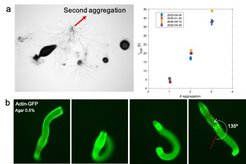
Collective self-organization and multicellularity
We study collective cell migration and self-organization in the model organisms, namely Dictyostelium discoideum (Dicty cells), which is an excellent example for transformation from single cell to multicellular organisms. We look for the physical parameters which can affect both self-organization and multicellularity process in Dictyostelium. Our work resulted in the following observations:
Dictyostelium, which is known to have a life cycle (about 24 hours) with a single aggregation cycle, can undergo several aggregation phases and life cycles if it is overpopulated in a small surface area. We observed up to 6 aggregation cycles, which extended over several days, with periodic time points. We hypothesize that there is a resetting mechanisms in the cells, similar to a statistical resetting, in which chemical signaling is reset and aggregation repeats itself repeatedly (manuscript under preparation).
In a slug form of Dicty cells (aggregation of hundred thousand of cells), We have identified two different cell motility dynamics, a helical rotation at the tip of the slug and a circular rotation at the body part of the slug. We could show that by coupling these two motility forms, the slug moves faster than individual cells, navigates on a substrate and rises to form the fruiting body (manuscript under preparation).

